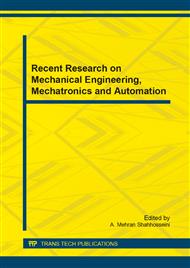[1]
A. R. Zak, M. L. Williams, Crack point stress singularities at a bi-material interface, J. Appl. Mech., 30 (1963) 142-143.
DOI: 10.1115/1.3630064
Google Scholar
[2]
T. S. Cook, F. Erdogan, Stresses in bonded materials with a crack perpendicular to the interface, Int. J. Eng. Sci., 10(1972) 677-697.
DOI: 10.1016/0020-7225(72)90063-8
Google Scholar
[3]
W.C. Wang, J.T. Chen, Theoretical and experimental re-examination of a crack at a bimaterial interface, J. Strain Anal., 28(1993) 53–61.
Google Scholar
[4]
D. H. Chen, A crack normal to and terminating at a bimaterial interface, Engng. Fract. Mech., 49 (1994) 517-532.
Google Scholar
[5]
S. A. Meguid, M. Tan and Z. H. Zhu, Analysis of cracks perpendicular to bimaterial interfaces using a novel finite element, Int. J. Fract., 73 (1995) 1-23.
DOI: 10.1007/bf00039848
Google Scholar
[6]
W. K. Lim, C. S. Lee, Evaluation of stress intensity factor a crack normal to bimaterial interface using isoparametric finite elements, Engng. Fract. Mech., 52(1995) 65-70.
DOI: 10.1016/0013-7944(94)00327-e
Google Scholar
[7]
S. Lahiri, B. V. Sankar, P. A. Mataga, Evaluation of bimaterial stress intensity factors using a finite element –boundary element alternating method, Engng. Fract. Mech., 53(1996) 289-302.
DOI: 10.1016/0013-7944(94)00302-5
Google Scholar
[8]
K. Kaddouri, M. Belhouari, B. Bachir Bouiadjra, B. Serier, Finite element analysis of crack perpendicular to bi-material interface: Case of couple ceramic–metal[J], Computational Materials Science, 2006, 35: 53–60.
DOI: 10.1016/j.commatsci.2005.03.003
Google Scholar
[9]
J. Chang and J. Q. Xu, The singular stress field and stress intensity factors of a crack terminating at a bi-material interface, Int. J. Mechanical Sciences, 49 (2007) 888-897.
DOI: 10.1016/j.ijmecsci.2006.11.009
Google Scholar
[10]
L. Marsavina and T. Sadowski, Crack – Interface Interaction in Composite Materials, In. Security and Reliability of Damaged Structures and Defective Materials, G. Pluvinage and A. Sedmak eds. (2009) 139-155.
DOI: 10.1007/978-90-481-2792-4_6
Google Scholar
[11]
L. Marsavina, T. Sadowski and N. Faur, Asymptotic stress field for a crack normal to a ceramic– metal interface, Key Engng. Mater., 417-418 (2010) 489-492.
DOI: 10.4028/www.scientific.net/kem.417-418.489
Google Scholar
[12]
Chang-Rong Chen, Yiu-Wing Mai, Comparison of cohesive zone model and linear elastic fracture mechanics for a mode I crack near a compliant/stiff interface, Engng. Fract. Mech., 77(2010) 3408-3417.
DOI: 10.1016/j.engfracmech.2010.09.009
Google Scholar
[13]
Liviu Marsavina1, Tomasz Sadowski, Nicolae Faur. Numerical investigation of the stress field near a crack normal to ceramic–metal interface. Journal of Mechanical Science and Technology, 25(2011) 309-315.
DOI: 10.1007/s12206-010-1209-3
Google Scholar


